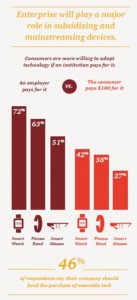![]() Headphones and smartphones are the top two electronics products U.S. consumers intend to purchase in 2015. But the emerging consumer electronics categories of wearable fitness trackers, smart watches, and smarthome devices (especially “smart” thermostats) are positioned to grow, too, in 2015, according to the 17th Annual CE Ownership and Market Potential Study from the Consumer Electronics Association (CEA).
Headphones and smartphones are the top two electronics products U.S. consumers intend to purchase in 2015. But the emerging consumer electronics categories of wearable fitness trackers, smart watches, and smarthome devices (especially “smart” thermostats) are positioned to grow, too, in 2015, according to the 17th Annual CE Ownership and Market Potential Study from the Consumer Electronics Association (CEA).
Wearable trackers have an installed base of about 17 million devices in the U.S., with 11% of U.S. households intending to purchase a tracker in 2015 — 6 percentage points up from 2014 (about a 50% increase over 2014). There are about 6 million smart watches on U.S. adults’ wrists, with 5% more households planning to buy one in 2015.
The other side of the fitness-tracker coin found in the survey is that 56% of U.S. adults say they would “never buy” this technology. 61% of consumers wouldn’t ever buy a smart watch, and 55% wouldn’t buy a smart thermostat.
The CEA
The CEA polled a national sample of 2,016 U.S. adults in January 23 and February 1, 2015, for the study.
Health Populi’s Hot Points: My parents taught me to “never say never,” so let’s put the “never would buy” a wearable tracker or smart watch into some perspective. In the exhaustive 477-page report, CEA concludes that it will be a “challenging year” for standalone, dedicated-use consumer electronic devices. These products include things like digital cameras, camcorders, portable MP3 players, GPS devices and the like — the kinds of objects whose applications are now performed by lite, inexpensive apps on smartphones. Smartphones, on the other hand, are much-demanded, with 72% market penetration anticipated in 2015 — 8 percentage points over 2014 when 64% of U.S. households had at least one smartphone.
 For wearable health trackers and smart watches, CEA says that, “In order for growth to continue, education of the benefits and reason for purchase need to be at the forefront of marketing for the products.” The third graphic illustrates the trend that enterprises will play a growing role in subsidizing (read: paying for or deeply discounting) and mainstreaming devices, based on research from PwC’s Health Research Institute.
For wearable health trackers and smart watches, CEA says that, “In order for growth to continue, education of the benefits and reason for purchase need to be at the forefront of marketing for the products.” The third graphic illustrates the trend that enterprises will play a growing role in subsidizing (read: paying for or deeply discounting) and mainstreaming devices, based on research from PwC’s Health Research Institute.
For consumers, price and cost are key elements in the growing retail health era. PwC found that consumers’ views on adopting the use of a wearable device for health tracking would highly depend on who pays for the device. If an “enterprise” (read: employer or health insurance plan) gifts such a device to an employee or plan member, the consumer would more like begin to use the device. If that supporting entity would continue to provide an incentive or payment to that consumer, continued use would be more likely to sustain.
So “never say never” when it comes to consumers opting out from using a wearable. A substantial discount on a health insurance premium could move the needle for a large percentage of “never” consumers.
Stay tuned to Health Populi tomorrow, Tuesday 19 May 2015, when I will report out just how much health will cost a family of four in the U.S. based on the 2015 Milliman Medical Index. Hint: that needle-moving I just talked about? The dollar savings could be a couple of months’ rent on a one-bedroom apartment in Washington DC in 2015.




 Interviewed live on BNN Bloomberg (Canada) on the market for GLP-1 drugs for weight loss and their impact on both the health care system and consumer goods and services -- notably, food, nutrition, retail health, gyms, and other sectors.
Interviewed live on BNN Bloomberg (Canada) on the market for GLP-1 drugs for weight loss and their impact on both the health care system and consumer goods and services -- notably, food, nutrition, retail health, gyms, and other sectors. Thank you, Feedspot, for
Thank you, Feedspot, for  As you may know, I have been splitting work- and living-time between the U.S. and the E.U., most recently living in and working from Brussels. In the month of September 2024, I'll be splitting time between London and other parts of the U.K., and Italy where I'll be working with clients on consumer health, self-care and home care focused on food-as-medicine, digital health, business and scenario planning for the future...
As you may know, I have been splitting work- and living-time between the U.S. and the E.U., most recently living in and working from Brussels. In the month of September 2024, I'll be splitting time between London and other parts of the U.K., and Italy where I'll be working with clients on consumer health, self-care and home care focused on food-as-medicine, digital health, business and scenario planning for the future...